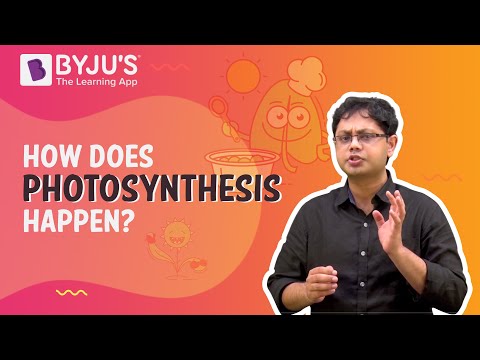Introduction
Photosynthesis is a process by which plants create their own food by using sunlight. This process was first seen more than 3.4 billion years ago in organisms that were similar to bacteria. Evidence showed that they did not absorb visible light, instead, they used near-infrared and produced sulphur or sulphate compounds. It would be another 470 million years until the first land plants emerged.
Related Links: Important Questions for Class 11 Biology-Photosynthesis in Higher Plants
Joseph Priestley Experiment
He enclosed a mouse within a bell jar and after a while, the mouse apparently died. He replicated the same experiment with a burning candle and eventually, the flame was extinguished. But when the repeated the above experiment with a mint plant, the mouse survived and the flame sustained. This outcome led Priestley to conclude that plants contribute to the production of oxygen.
Where Does Photosynthesis Take Place?
Essentially, this process takes place inside a plant cell organelle called the chloroplast. These organelles are found in the mesophyll layer, which is basically two layers of cells present inside the leaves of the plant. Chloroplasts orient themselves through the walls of the mesophyll cells so as to garner most of the light incident on it. The membranous system in the chloroplast consisting of grana, the matrix stroma and stroma lamellae exhibit division of labour. The system is in charge to trap light energy, also for the ATP and NADPH synthesis, with the conduction of light reactions and dark reactions.
For More Information On Photosynthesis, Watch The Below Videos:


Electron Transport
- Chlorophyll in photosystem II absorbs the red light wavelength causing electrons to excite and jump into an orbit away from the atomic nucleus
- Thereafter the electrons are picked up by electron acceptor passing them to electrons transport system comprising cytochromes where electron movement is downhill(redox potential scale)
- The electrons are not used but passed on pigments of photosystem PS I of the chain. Parallelly, PS I electrons in reaction centres are excited upon receiving red light wavelength transferring to another receptor molecule having greater redox potential through the Z scheme(characteristic shape) formed when all carriers are arranged in a sequence of a redox potential scale.
Cyclic and Non-cyclic Photophosphorylation
Photophosphorylation is the formation of ATP in the presence of sunlight and is of two types – Cyclic and Non-cyclic Photophosphorylation.
Cyclic Photophosphorylation – Here only PS-I is involved. Here the electrons circulate inside the photosystem resulting in a cyclic electron flow resulting in the formation of ATP alone.
Non-cyclic Photophosphorylation:
- PS-II absorbs light at a wavelength of 680 nm and causing excitation of electrons which are accepted by an electron acceptor and transferred to the electron transport system. These are then transferred to the PS-I. Simultaneously, the electrons at PS-I receive a wavelength of 700 nm and get excited.
- An electron from the electron acceptor is added to NADP+, which is then reduced to NADPH+ H+.
- The electrons lost by PS-II do not return to it and therefore referred to as non-cyclic photophosphorylation.
- In this, both the photosystems were involved.
Further Reading: Chemiosmotic Hypothesis
Calvin Cycle
Calvin Pathway occurs in all photosynthetic plants. It can be described in the following three stages –
- Carboxylation – it is the fixing of carbon dioxide into a stable organic intermediate. This is catalyzed by enzyme – RuBP carboxylase resulting in the formation of two molecules of 3-PGA. It is referred to as RuBP carboxylase-oxygenase(RuBisCO) as it also has oxygenation activity
- Reduction – Sequence of reactions leading to the formation of glucose
- Regeneration – For the uninterrupted continuation of the cycle, the carbon dioxide acceptor molecule RuBP must be regenerated which requires one ATP molecule for RuBP formation.
Know more: C3 and C4 Pathway
Photorespiration
There is no formation of ATP or NADPH in this process. Here, the plants consume oxygen and give out carbon dioxide. All this in the presence of light. Read more on photorespiration, here.
Factors Affecting Photosynthesis
Blackman’s Laws of Limiting factors comes into the picture when many factors affect any chemical process. The law states – ” If a chemical process is affected by more than one factor, then its rate will be determined by the factor which is nearest to its minimal value: it is the factor which directly affects the process if its quantity is changed.”
The various factors are:
- Light
- Carbon dioxide concentration
- Temperature
- Water
Questions on Photosynthesis in Higher Plants
- Explain the following in brief
- C3 Plants
- RuBisCO
- Photophosphorylation
- Is it possible to determine if a plant is C3 or C4 based on external appearance alone?
- Differentiate the anatomic differences between C3 and C4 plants.
| Also Access |
| NCERT Solutions for class 11 Biology Chapter 13 |
| NCERT Exemplar for class 11 Biology Chapter 13 |
To explore more questions or concepts related to photosynthesis in higher plants Class 11 Notes, register at BYJU’S.
Further Reading:-
| Pigments | Photosynthesis |
Frequently asked Questions on CBSE Class 11 Biology Notes Chapter 13: Photosynthesis in Higher Plants
Who was Joseph Priestley?
Joseph Priestley was a hugely productive person in the research field. He invented the carbonated water and also thr rubber eraser.
What is electron transport?
The sequential transfer of electrons especially by cytochromes during cellular respiration is known as electron transport. This is usually carried out oxygen-reduction reactions.
What is Photophosphorylation?
The coversion of ADP to ATP using the energy of sunlight.
Comments